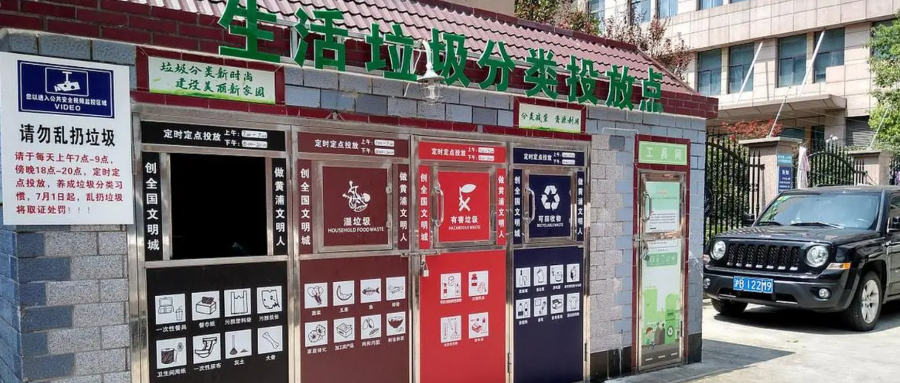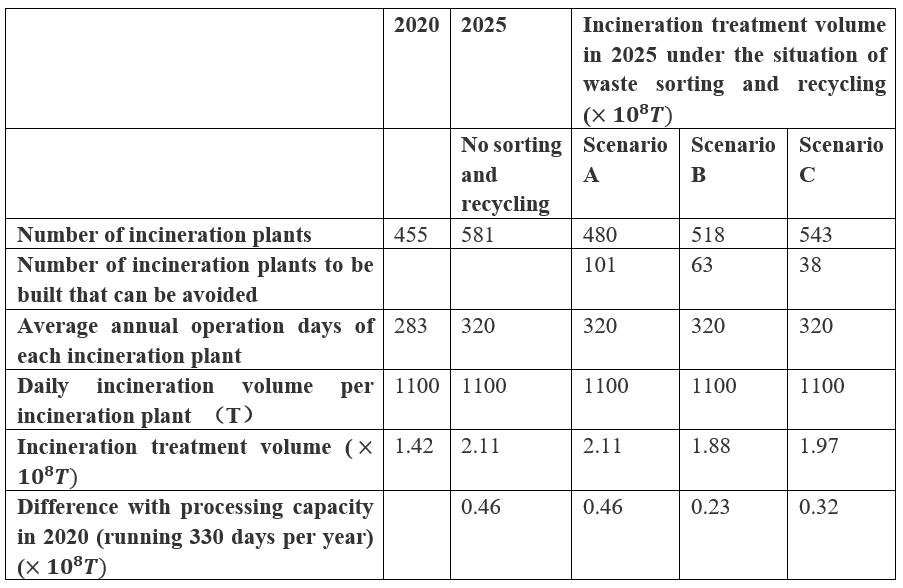

July 1, 2019 was a monumental day for waste segregation in China. As the city with the fastest economic development in China, Shanghai took the lead in kicking off waste seperation in China. In 2020, various parts around the country began to introduce corresponding measures, in response to the waste seperation policy, which has made the future of China's waste management full of challenges. As the 13th Five-Year Plan draws to a close, policy topics such as waste segregation and incineration subsidies have attracted renewed attention. On June 30, 2020, Rock Environment and Energy Institute (REEI) will host an online seminar titled "The Risks of Excess Waste Incineration Capacity in the 14th Five-Year Plan" to discuss these popular topics.
Shanghai has achieved remarkable results in the first year of waste sorting and recycling, with the amount of dry waste disposed of by the end of 2019 reduced by 17.5% compared with the end of 2018. [1] The effect of municipal solid waste (MSW) classification and recovery will directly affect MSW incineration treatment capacity and operation efficiency. Generally speaking, if the waste sorting and recycling is efficient, the dry and wet separation is meticulous, then with kitchen waste and organic waste composting and anaerobic digestion in place, the waste water content of final incineration will be low, the calorific value will be high, and the incineration efficiency will be correspondingly high. If this positive effect in Shanghai translates to more cities in China over the next five years, China's waste management will change significantly. Incineration, which currently dominates waste treatment, will face huge challenges, where the reduction of waste caused by sorting is also likely to make the scale and capacity of waste incineration treatment peak during the 14th Five-Year Plan period.
Better sorting and recycling, less incineration plants
Shanghai has implemented the MSW seperation since July 1, 2019, which will provide experience for the implementation of the long-awaited municipal solid waste sorting and recycling policies across the country during the 14th Five-Year Plan period. By 2025, what kind of effect will be achieved in the sorting and recycling of municipal solid waste in China? Based on the results achieved in Shanghai in the second half of 2019, three waste sorting and recycling scenarios are predicted as a result of sorting and recycling of municipal solid waste by 2025.
· High-speed development scenario A: By 2025, the sorting and recycling measures will make 100% of the country's MSW that flows into the tail-end disposal reduce its volume by 17.5% compared with2020 level;
· Medium-speed development scenario B: by 2025, the sorting and recycling measures will make 50% of the country's MSW that flows into the tail-end disposal reduce its volume by 17.5% compared with2020 level; Another 25% of MSW is 8.5% below 2020 level, while the remaining 25% stays the same;
· Low-speed development scenario C: by 2025, the sorting and recycling measures will make 25% of country's MSW that flows into the tail-end disposal reduce its volume by 17.5% compared with 2020 level; Another 25% was 8.5% below 2020 level, while the remaining 50% stays the same.
In the article "Increasing the running time of existing incineration plants: How many incineration plants construction can be avoided during the 14th Five-year Plan?", we once assumed that the growth rate of landfilling waste volume during the 14th Five-year Plan will be zero, so the waste reduction under the three development scenarios will mainly affect the waste incineration treatment. In addition, the article also predicted the high and low growth scenarios of incineration treatment volume in 2025 without the waste separation policy, which were 226 million tons and 195 million tons respectively, assuming the median value of 211 million tons was taken as the annual incineration treatment volume in 2025 without the waste separation policy, as shown in Table 1. If the average annual days of incineration plants operation in China reach 330 in 2020, then the waste incineration capacity will reach 165 million tons in 2020. Even if the average operation days of incineration plants in 2020 does not reach 330, its potential may be realized or be close to the ideal level of 330 days by the middle of the 14th Five-Year Plan period.
Table 1: Impact of waste sorting and recycling on incineration treatment 
Data source: Derived from scenario analysis
As of June 1, 2020, China had 455 waste incineration plants. [2] If this figure remains constant and the number of operation days increases to 330, the total waste management capacity of 165 million tons will be 9 million tons, 23 million tons, 32 million tons and 46 million tons less than that of high, medium, low and, non-sorting and recycling scenarios by 2025 respectively. If the difference in incineration capacity was converted into the number of incineration plants, the following results can be obtained: Compared with the scenario without sorting and recycling, only 25, 63 and 88 incineration plants need to be built respectively under the three scenarios with different sorting and recycling results. Compared with the scenario without sorting and recycling requiring 581 incineration plants, 101, 63 and 38 incineration plants construction can be avoided respectively under the three scenarios.
The inflection point of incineration treatment scale is expected to appear at the end of the 14th Five-Year Plan
The five year results of national waste sorting and recycling should exceed that of Shanghai's with only half a year time. The scenario analysis in this article estimates the effect of waste sorting and recycling in the 14th Five-year Plan rather conservatively. In scenario A, only 25 new incineration plants, on top of the existing 455, would be needed to meet incineration capacity requirements by 2025. If the actual effect of sorting and recycling is better than scenario A, for example, by 2025, if the sorting and recycling measures ensure 100% of MSW in the country that flows into the tail-end disposal reduce its volume by 21.5% compared with the level in 2020, which is 4% higher than 17.5%, then the total amount of waste entering the tail-end disposal for incineration will be 166 million tons. This is similar to the amount of waste that 455 incineration plants process for 330 days a year (165 million tons). In this case, the focus on incineration during the 14th five-year Plan will be on increasing the operation days of incineration plants, rather than building new ones. The efficiency of sorting and recycling will continue to improve after 2025, when the number of incineration plants may enter a new phase of reduction. From this point of view, 2025 is likely to become a turning point in the development of waste incineration industry.
Some may argue that during the 14th Five-Year Plan period, the proportion of landfill treatment will not only continue to decrease due to the increase in incineration, but also likely to decrease in the absolute amount of landfill treatment, which may lead to additional waste for incineration. However, the implementation of sorting and recycling policy, while increasing the waste amount for composting, anaerobic digestion and improving the recycling rate, will also reduce the waste amount going to landfill, reduce the pressure of insufficient landfill treatment capacity. In order to maintain normal operations, landfills with an existing capacity of 117 million tons will also have the inertia to dispose of waste with the current method, and will not easily reduce the volume of landfilling to compensate for more waste going into incineration plants. As for whether landfills and incineration plants will compete for waste disposal capacity in the future, the influencing factors are complex and need to be further studied.
Mission of the era: The precious five years
In the article “Waste incineration: A decade of lagging behind; How do cities build a sustainable MSW management system?”, the author pointed out that relying on incineration has cost China five precious years in sustainable waste management. Instead of following the Japanese path of ultra-high incineration rates, Chinese policymakers should follow the German model of waste management and accelerate the implementation of sorting and recycling policies, rapidly improve its effect on waste reduction, and effectively reduce the reliance on tail-end disposal (especially incineration). In the context of tackling climate change and developing green economy, the development trend of MSW management in 2030 and 2050 in China predicts sorting and recycling would play its due role and results. China's MSW sustainable management can not lose another five years, but should use the 14th Five-Year Plan" to adjust the traditional method of waste management into a sustainable one.
Note:
[1] 央视网新闻,“上海生活垃圾分类‘年报’出炉 分类效果正在显现”. Link: http://m.news.cctv.com/2020/04/29/ARTIWiWkWXX5jGK6aIaRyzL4200429.shtml
[2] 生态环境部公开2020年第一季度生活垃圾焚烧发电厂环境违法行为处理处罚情况. Link:http://www.envsc.cn/details/index/6714
Author:Zhao Ang
Translation: Chen Shikai
Proofread: Pan Yiren
This article is an original article of the Rock Environment and Energy Institute. Please contact us to obtain the appropriate authorization to reprint. For cooperation and authorization, please send an email to: liying@reei.org.cn
* This is the translation of an article in Chinese. Should there be any inconsistency between Chinese and English version, the Chinese version shall prevail.




